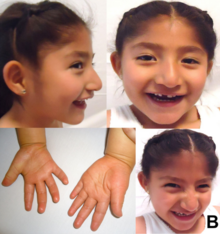| Angelman syndrome | |
|---|---|
| Other names | Angelman's syndrome[1][2] |
 | |
| A five-year-old girl with Angelman syndrome. Features shown include telecanthus, bilateral epicanthic folds, small head, wide mouth, and an apparently happy demeanor; hands with tapered fingers, abnormal creases and broad thumbs. | |
| Pronunciation | |
| Specialty | Medical genetics |
| Symptoms | Delayed development, unusually happy, intellectual disability, limited to no functional speech, balance and movement problems, small head, seizures[6] |
| Usual onset | Noticeable by 6–12 months[6] |
| Causes | Genetic (new mutation)[6] |
| Diagnostic method | Based on symptoms, genetic testing[7] |
| Differential diagnosis | Cerebral palsy, autism, Rett syndrome, Prader–Willi syndrome[7][8] |
| Treatment | Supportive care[7] |
| Prognosis | Nearly normal life expectancy[6] |
| Frequency | 1 in 12,000 to 20,000 people[6] |
Angelman syndrome (AS) is a genetic disorder that mainly affects the nervous system.[6] Symptoms include a small head and a specific facial appearance, severe intellectual disability, developmental disability, limited to no functional speech, balance and movement problems, seizures, and sleep problems.[6] Children usually have a happy personality and have a particular interest in water.[6] The symptoms generally become noticeable by one year of age.[6]
Angelman syndrome is due to a lack of function of part of chromosome 15, typically due to a new mutation rather than one inherited.[6] Most often it is due to a deletion or mutation of the UBE3A gene on that chromosome.[6] Occasionally it is due to the inheritance of two copies of chromosome 15 from the father and none from the mother (paternal uniparental disomy).[6] As the father's versions are inactivated by a process known as genomic imprinting, no functional version of the gene remains.[6] Diagnosis is based on symptoms and possibly genetic testing.[7]
No cure is available.[7] Treatment is generally supportive in nature.[7] Anti-seizure medications are used in those with seizures.[7] Physical therapy and bracing may help with walking.[7] Those affected have a nearly normal life expectancy.[6]
AS affects 1 in 12,000 to 20,000 people.[6] Males and females are affected with equal frequency.[7] It is named after British pediatrician Harry Angelman, who first described the syndrome in 1965.[7][9] An older term, happy puppet syndrome, is generally considered pejorative.[10] Prader–Willi syndrome is a separate condition, caused by a similar loss of the father's chromosome 15.[11]
- ^ a b "Angelman syndrome". Oxford English Dictionary. Archived from the original on June 17, 2020 – via Lexico.com.
- ^ a b c "Angelman syndrome". Merriam-Webster Medical Dictionary. Merriam-Webster. Retrieved April 15, 2022 – via Merriam-Webster.com.
- ^ "Angelman syndrome". McGraw-Hill Dictionary of Scientific & Technical Terms. The McGraw-Hill Companies, Inc. 2003. Retrieved April 15, 2022 – via thefreedictionary.com.
- ^ a b "Angelman syndrome". American Heritage Medical Dictionary (2007 ed.). Houghton Mifflin Company. 2004. Retrieved April 15, 2022 – via thefreedictionary.com.
- ^ Urraca N, Reiter L (2013). "Angelman syndrome". Comprehensive Developmental Neuroscience: Neural Circuit Development and Function in the Heathy and Diseased Brain. Elsevier Inc. Chapter 32. ISBN 9780128063415. Retrieved April 15, 2022 – via Google Books.
- ^ a b c d e f g h i j k l m n o "Angelman syndrome". ghr.nlm.nih.gov. Genetics Home Reference, US National Institutes of Health. May 2015. Archived from the original on 27 August 2016. Retrieved 28 April 2017.
- ^ a b c d e f g h i j "Angelman Syndrome". rarediseases.org. National Organization for Rare Disorders (NORD). 2015. Archived from the original on 13 November 2016. Retrieved 28 April 2017.
- ^ "Common Misdiagnoses". Foundation For Angelman Syndrome Therapeutics. 2 August 2019. Retrieved 10 March 2024.
- ^ Angelman H (1965). "'Puppet' Children: A report of three cases". Developmental Medicine & Child Neurology. 7 (6): 681–688. doi:10.1111/j.1469-8749.1965.tb07844.x. S2CID 53730099.
- ^ Wilson GN, Cooley WC (2000). Preventive Management of Children with Congenital Anomalies and Syndromes. Cambridge University Press. p. 193. ISBN 9780521776738. Archived from the original on 2017-11-05.
- ^ Kumar V, Abbas AK, Aster JC (2013). "Genetic and Pediatric Diseases". Robbins Basic Pathology. Elsevier Health Sciences. p. 244. ISBN 978-1437717815. Archived from the original on 2017-11-05. Retrieved 2022-04-15 – via Google Books.